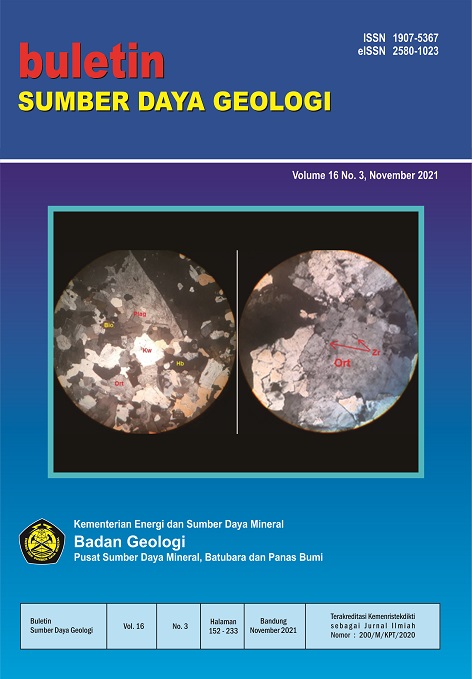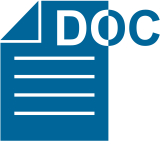KARAKTERISTIK ALTERASI DAN MINERALISASI CEBAKAN TEMBAGA DI DAERAH SETELUK DAN SEKITARNYA, KABUPATEN SUMBAWA BARAT, PROVINSI NUSA TENGGARA BARAT
THE CHARACTERISTIC OF ALTERATION AND MINERALIZATION OF COPPER DEPOSITS IN SETELUK AREA AND ITS SURROUNDING, WEST SUMBAWA DISTRICT, WEST NUSA TENGGARA PROVINCE
Abstract
The research was conducted by the background of gold mining community around the research area. The purpose of the study was to know the continuity and type of mineralization that had been previously found outside the study area. The methods used include geological mapping and geochemical sampling of river sediments, rocks and pan concentrates. Laboratory analysis carried out at PSDMBP includes chemical analysis of the AAS method, petrographic examination, mineragraphy, grain mineralogy and Spec-Terra. Mineralization in the Seteluk area and its surroundings is one of the most interesting forms of mineralization occurring in intrusive granodiorite, volcanic and sedimentary rocks. There are three forms of indication of mineralization, namely; Firstly is low sulfidation epithermal mineralization, characterized by the presence of quartz veins breaking through the argillic zone (illite, montmorillonite, and kaolinite) in the sandstone with mineral associations of chalcopyrite, sphalerite, galena and pyrite. Both high sulfidation epithermal mineralizations are characterized by the presence of massive silica in which there is a localized vuggy silica structure of sulfur with alteration minerals of pyrophyllite, jarosite, and pyrite sulfide. The three porphyry indications are thought to occur in granodiorite with the main characteristics of epidote alteration, chlorite with veinlets and magnetite spots. The identified metallic minerals have associations of magnetite, ilmenite, chalcopyrite, galena, sphalerite, covelite and iron oxide. The results of rock chemistry analysis showed the highest Au content was 98 ppb; Cu 774 ppm, Pb 7993 ppm and Zn 23007 ppm. Indications of Au and Cu mineralization are also known from panning results in the form of gold and chalcopyrite grains with the percentage of chalcopyrite grains reaching 53%. The alteration and mineralization pattern shows the appearance of magnetite with ilmenite, chalcopyrite and pyrite in the granodiorite intrusion which is estimated to be a potassic zone (?) then towards the outside of the silica zone, advanced argillic, argillic zone and the outermost propylite zone. This area is thought to be a porphyry (?) type mineralization system in the interior, followed by high sulfidation and then low sulfidation epithermal mineralization with mineralization centers estimated to be below the surface.
Downloads
References
Alpers C. N., Nordstrom D. K. and Ball J. W. (1989) Solubility of jarosite solid solutions precipitated from acid mine waters, Iron Mountain, California. U.S.A. Sci. Geol. Bull. 42, 281–298.
Antonio Arribas, 1995, Characteristics of high-sulfidation epithermal deposits, and their relation to magmatic fluid, The University of Texas at El Paso, Texas, U.S.A.
Browne, P.R.L., Ellis, A.J., 1970: The Ohaki-Broadlands hydrothermal area, New Zealand: Mineralogy and related chemistry. American Journal. of Science 269, 97-133.
David L.H And Julienne K, 2001, Zonation of Alteration Facies at Western Tharsis, Implication for the Genesis of Cu-Au, Deposits Mount Lyell Field, Western Tasmania, Economic Geology Vol 96, pp.1123-1132
Hedenquist, J.W., 1996, Epithermal gold deposits: style, characteristics and exploration, Resources Geology Spec. Issue No1.
Heinrich, E.W. 1965, Microscopic Identification of Minerals, Glasgow USA.
Mangga, S A Sudradjat, S., dan Suwarna N., 1998, Geologi Lembar Sumbawa Barat NusaTenggara, PPPG, Bandung.
Pirajno, Franco, 2016, Hydrothermal mineral system, Module Training ‘Exploration and Development of Mineral Resources’, KIGAM South Korea.
Sillitoe, R.H., 1999a, Styles of high-sulphidation gold, silver and copper mineralization in the porphyry and epithermal environments, in Weber, G., ed., Pacrim ’99 Congress, Bali, Indonesia, 1999, Proceedings: Parkville, Australasian Institute of Mining and Metallurgy, p. 29-44.
Simanjuntak, T.O. and Barber, A.J., 1996, Contrasting Tectonic Styles In The Neogene Orogenic Belts of Indonesia, Tectonic Evolution of Southeast Asia, Geological Society Special Publication, vol. 106, no. 1, hal. 185-201.
Stoffregen, R. (1987) Genesis of Acid-Sulfate Alteration and Au-Cu-Ag Mineralization at Summitville, Colorado. Economic Geology, 82, 1575-1591
Stoffregen R. E., Alpers C. N. and Jambor J. L. (2000) Alunite–jarosite crystallography, thermodynamics, and geochronology. Soc. Am. Rev. Mineral. Geochem. 40, pp. 453–479
Sudradjat A, S.,Mangga, A, dan Suwarna N., 1998, Geologi Lembar Sumbawa Barat Nusa Tenggara, PPPG, Bandung
Syuhada, D. Hananto, Chalid I. Abdullah, Nanang T. Puspito, Tedi Yudistira and Titi Anggono 2017, Study on 2-D Crustal Shear Wave Splitting Tomography along The Sunda-Banda Arc Transition Zone Chalid Earth and Environmental Science, vol 62
Taylor, R.D., Hammarstrom, J.M., Piatak, N.M., and Seal II, R.R., 2013, Arc-related porphyry molybdenum deposit model: Chapter D in Mineral deposit models for resource assessment: U.S. Geological Survey Scientific Investigations Report USGS Numbered Series 2010-5070-D
Copyright (c) 2021 Buletin Sumber Daya Geologi

This work is licensed under a Creative Commons Attribution-NonCommercial-ShareAlike 4.0 International License.
Authors whose manuscripts are published agree to the following terms:
The publication rights of all journal manuscript materials published on the Buletin Sumber Daya Geologi website are held by the editorial board with the knowledge of the author (moral rights remain with the manuscript’s author).
The formal legal provisions for access to digital articles in this electronic journal are subject to the terms of the Creative Commons Attribution-ShareAlike (CC BY-SA) license. This means that Buletin Sumber Daya Geologi has the right to store, convert media/formats, manage in the form of a database, maintain, and publish the article without requesting permission from the author, as long as the author’s name is cited as the copyright holder.
Manuscripts published in both print and electronic formats are open access for educational, research, investigative, and library purposes. Beyond these purposes, the editorial board is not responsible for any violations of copyright law.















